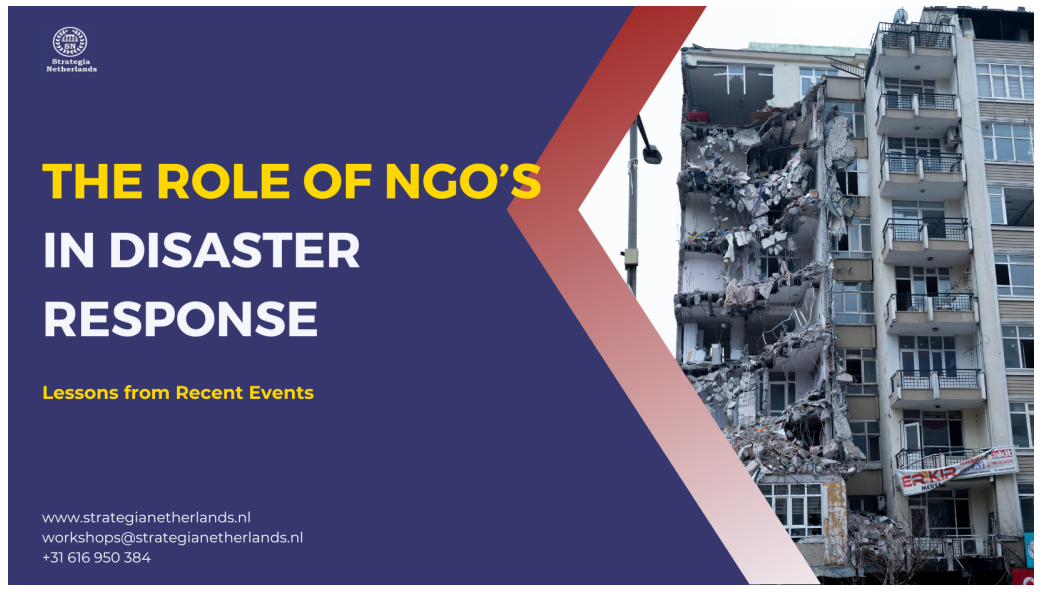- October 2, 2023
- Posted by: strategia
- Categories: blog posts, Uncategorized

Disasters can strike at any moment, leaving communities devastated and in dire need of immediate assistance. While government agencies and international organizations play essential roles in disaster response, often the first responders on the scene are not trained professionals but rather the local communities themselves. Recent events, including earthquakes and their aftermath, highlight the critical role of Non-Governmental Organizations (NGOs) in disaster response. This article examines the lessons learned from the recent
Morocco earthquake and underscores the significance of NGOs in providing rapid and effective assistance during crises.
Local Communities as First Responders:
In the immediate aftermath of a devastating earthquake, it’s often the neighbors and local residents who are the first to lend a helping hand. Forrest Lanning, an earthquake and volcano response liaison with the Federal Emergency Management Agency, emphasized that the immediate community has the most substantial impact on rescue efforts. These local responders are already present on the ground, right when the disaster occurs.
The Importance of Community Training:
To maximize the effectiveness of local responders, it is crucial to spread awareness and provide training in disaster response. The Community Emergency Response Team (CERT) program inthe United States, run by FEMA, trains volunteers across all 50 states in basic disaster
response skills. This includes educating people on what to do after an earthquake, where to find water, how to check on immobile neighbors, and even how to search for and rescue individuals trapped in collapsed buildings.
Early Response Is Critical:
Experts emphasize that the first 12 hours to two days following a disaster are the most crucial for search and rescue efforts. The window of opportunity to save people trapped under rubble narrows quickly, and by day four or five, it’s often too late. Even if bystanders cannot physically extract individuals from debris, they can provide vital information to professional rescue teams about the location of survivors, greatly improving the chances of survival.
Shortage of Local Search and Rescue Teams:
In many disaster-stricken regions, especially those prone to earthquakes, there is often a shortage of local search and rescue teams. International teams may take 24 to 48 hours to arrive, leaving a critical gap in immediate response. This was evident in the recent earthquake in Samandağ, Turkey, where civilians were digging through rubble for hours before a small group of rescuers arrived.
Military Mobilization:
Experts stress the need for immediate mobilization of military and rescue crews when a disaster strikes. The military is often best equipped to operate in the chaotic aftermath of a disaster, open airstrips for aid delivery, and provide critical support. However, in some cases, governments fail to activate the military promptly, which can lead to delays in rescue and relief
efforts.
Mitigation and Prevention:
While search and rescue operations are crucial, mitigation and prevention efforts are equally vital in minimizing disaster losses. Building codes, retrofitting infrastructure, and enforcing policies based on scientific research are crucial steps in disaster preparedness.
Lessons from Morocco’s Recent Earthquake:
Morocco’s response to the earthquake that struck recently serves as a case study. The country faced a devastating earthquake that left thousands dead and many more injured. International organizations, including Isra AID, rushed to provide assistance, emphasizing the importance oftimely and effective aid delivery. Morocco’s earthquake also highlights the need for robust disaster management plans and the importance of international support in the face of large-scale disasters. Ireland’s contribution of €2 million and Google’s use of its products, services, and funding to assist Morocco’s relief endeavors demonstrate the global community’s solidarity in times of crisis.
Conclusion
Recent events have shown us that NGOs, local communities, and international assistance are all critical components of effective disaster response. Local communities, when trained and organized, can be the first responders, and NGOs often play a pivotal role in bridging the gap between immediate response and long-term recovery. While disasters can be devastating, they also remind us of the importance of preparedness, research, and collaboration to save lives and
build more resilient communities in the face of future crises.
